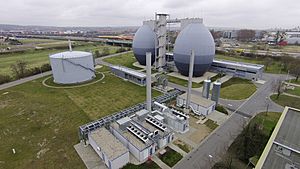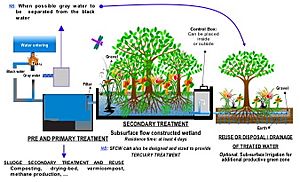Sewage treatment facts for kids
Sewage treatment is a super important process that cleans dirty water, called sewage. This water comes from our homes, schools, and factories through pipes called sewers. If we didn't clean it, this dirty water could harm people and pollute our rivers and oceans. When sewage arrives at a treatment plant, it goes through many steps to make it safe again. Bigger plants usually have more steps than smaller ones.
Contents
First Steps: Getting Rid of Big Stuff
The very first thing that happens at a sewage treatment plant is removing large objects. Imagine giant screens, like strainers, that catch things like rags, plastic bottles, or even toys that accidentally got flushed. These big items are taken out so they don't damage the machines later in the cleaning process.
After the screens, the water flows into a special tank. Here, heavier things like sand and grit (tiny stones) sink to the bottom. This step is important because sand can be very abrasive and wear out pumps and other equipment.
Primary Cleaning: Settling Out Solids
Next, the sewage moves into a large settling tank, sometimes called a primary tank. In this tank, the water slows down a lot. This allows tiny solid bits, called sludge, to sink to the bottom. At the same time, lighter things like fat and grease float to the top. Special equipment then scrapes off the fat from the surface and collects the sludge from the bottom. The water that leaves this tank is much clearer, but it's still not clean enough.
Secondary Cleaning: Bacteria to the Rescue!
The water that leaves the primary tank still has a lot of dissolved dirt and tiny particles. This is where bacteria and other very small living things become our cleaning heroes! This stage is often called secondary treatment. These helpful bacteria love to eat the remaining chemicals and organic matter in the sewage. To do their job well, they need oxygen from the air, just like we do.
There are different ways to help these bacteria clean the water:
- Ponds: In some smaller plants, the cleaning bacteria live in large, shallow ponds. The water stays in these ponds for a long time, allowing the bacteria to naturally break down the pollutants.
- Trickling Filters: Other plants use large beds filled with rocks or pieces of plastic. The water is sprayed over these materials, and the bacteria grow in a slimy layer on their surfaces. As the water trickles down, the bacteria eat the pollutants.
- Activated Sludge: Many large plants use a method called activated sludge. Here, air is blown into large tanks to mix the water with lots of active bacteria. These bacteria form small clumps. They work quickly to eat the chemicals in the water.
After the bacteria have done their job, the water flows into another settling tank, often called a secondary tank. Here, the clumps of bacteria (which are now heavier because they've eaten the pollutants) sink to the bottom. The cleaned water then leaves from the top. Some of these bacteria clumps are pumped back to the mixing tank to help clean the next batch of dirty water.
Final Touches: Making Water Super Safe
The clean water from the secondary tank can often be released into a river or the sea. However, sometimes it needs even more treatment to make it extra clean, especially if it's going into a sensitive environment or if people might come into contact with it.
Some plants add a final step to kill any remaining harmful bacteria or viruses that could make people sick. This is called disinfection. They might use:
- Chemicals: Some plants use special poisons, like chlorine, to kill germs.
- Light: Other plants use strong ultraviolet (UV) light, which is the same kind of light that causes a sunburn. This light destroys the germs without adding chemicals to the water.
What Happens to the Solids?
The solid material (sludge) collected from the first and second settling tanks is also treated. This sludge is full of organic matter. It can be processed in special tanks where it produces methane gas, which can be used as a fuel! The remaining solid material can then be used as a fertiliser for farmers' fields, returning valuable nutrients to the soil.
Images for kids
-
An activated sludge sewage treatment plant in Massachusetts, US, seen from above.
-
Constructed wetlands (vertical flow) used for sewage treatment near Shanghai, China.
-
Cleaned water being released from a sewage treatment plant in the Czech Republic into a river.
See also
 In Spanish: Tratamiento de aguas residuales para niños
In Spanish: Tratamiento de aguas residuales para niños





















